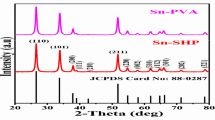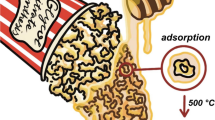Abstract
By reducing the size of semiconductor material up to nanoscale, the physical and chemical properties vary substantially, resulting in unique features due to their large surface area or the quantum size. Tungsten selenide (WSe2) nano semiconductor is synthesized by a solvothermal method using sodium tungstate and selenium powder as a precursor, PVP as a stabilizing agent, and urea as a precipitating agent. Structural information of material is elucidated by XRD, such as grain size and crystal orientation. Diffraction peaks are observed at 13.69°, 31.45°, 37.93°, 41.27°, 47.53°, 55.47°, 55.95° and 65.17° 2θ values which designate the (002), (100), (103), (006), (105), (110), (112) and (200), miller indices respectively. The XRD result shows that the structure of semiconducting nanoparticles is hexagonal in shape and purely crystalline. The SEM determined surface topography and morphology of material that particles are rod-like, and the average particle size of nanorods is 41 nm. By Fuel additive application, it is clear that WSe2 nano semiconductor dramatically affects the fuel’s properties and different parameters analyze its efficiency, i.e., fire and flash point, cloud and pour point, kinematic viscosity, specific gravity and calorific values. The previous research has shown that semiconducting nanoparticles are essential in degrading dyes from water. At nanoscale, WSe2 nano semiconductor has recently been developed as an efficient photocatalyst because of its attractive band gap estimated as 1.8609 eV. WSe2 is an excellent catalyst because that Kapp values increase linearly from 0.0023 to 0.0037 min−1 with increase in catalyst dose from 0.01 to 0.05 g. In addition, it behaves as a good additive because the calorific value increased from 10,263 to 31,930 Jg−1 by the increase in additive dose from 20 to 80 ppm.
Graphic Abstract












Similar content being viewed by others
References
M. Colombo, C. Minussi, S. Orthmann, S. Staufenbiel, and R. Bodmeier (2018). Eur. J. Pharm. Biopharm. 125, 159.
A. A. Kokorina, E. S. Prikhozhdenko, N. V. Tarakina, A. V. Sapelkin, G. B. Sukhorukov, and I. Y. Goryacheva (2018). Carbon. 127, 541.
V. Barreneche, R. Mondragon, D. Ventura-Espinosa, J. Mata, L. F. Cabeza, A. I. Fernández, and J. E. Julia (2018). Appl. Therm. Eng. 128, 121.
A. Bruix, J. V. Lauritsen, and B. Hammer (2018). Preprint at arXiv. 1805, 01244.
R. Vijayan, S. Joseph, and B. Mathew (2018). Artif. Cells. Nanomed. Biotechnol. 46, 861.
S. R. Khan, S. Ali, G. Zahra, S. Jamil, and M. R. S. A. Janjua (2020). Chem. Phys. Lett. 12, 137804.
M. R. S. A. Janjua (2019). Open. Chem. 17, (1), 865.
S. Jamil, A. R. Alvi, S. R. Khan, and M. R. S. A. Janjua (2019). Prog. Chem. 31, 394.
G.A. Mansoori, in Nanoscience and Plant–Soil Systems, ed. by M. Ghorbanpour, K. Manika, and A. Varma (Springer, cham, 2017), p. 3.
P. Livan and T. Öztürk (2018). J. Mater. Sci. 53, 14350.
C. Lee, S. K. Kim, J. H. Choi, H. Chang, and H. D. Jang (2018). J. Alloys Compd. 735, 2030.
K. Wu, B. Yang, X. Zhu, W. Chen, X. Luo, Z. Liu, X. Zhang, and Q. Liu (2018). New J. Chem. 42, 18749.
K. Klauke, D. H. Zaitsau, M. Bülow, L. He, M. Klopotowski, T. O. Knedel, J. Barthel, C. Held, S. P. Verevkin, and C. Janiak (2018). Dalton Trans. 47, 5083.
T. Wang, X. Chen, G. Q. Lu, and G. Y. Lei (2007). J. Electron. Mater. 36, 1333.
S. Liu, M. Li, C. Wang, P. Jiang, L. Hu, and Q. Chen (2018). ACS Sustain. Chem. Eng. 6, 9137.
P. Steinleitner, P. Merkl, P. Nagler, J. Mornhinweg, C. Schüller, T. Korn, A. Chernikov, and R. Huber (2017). Nano lett. 17, 1455.
P. C. Sherrell, K. Sharda, C. Grotta, J. Ranalli, M. S. Sokolikova, F. M. Pesci, P. Palczynski, V. L. Bemmer, and C. Mattevi (2018). ACS Omega. 3, 8655.
E. V. Calman, M. M. Fogler, L. V. Butov, S. Hu, A. Mishchenko, and A. K. Geim (2018). Nat. Comun. 9, 1.
G. Rehman, S. A. Khan, B. Amin, I. Ahmad, L. Y. Gan, and M. Maqbool (2018). J. Mater. Chem. C. 6, 2830.
S. Lepeshov, A. Krasnok, and A. Alu (2019). Nanotechnology. 30, 254004.
D. M. Wu, M. L. Solomon, G. V. Naik, A. García-Etxarri, M. Lawrence, A. Salleo, and J. A. Dionne (2018). Adv. Mater. 30, 1703912.
J.N. Milton, Optical studies of functionalized graphene and similar 2D materials (Published by university of exeter, 2017), http://hdl.handle.net/10871/32641. Accessed 11 Sep 2017.
G. Barik and S. Pal (2018). J. Phys. Chem. C. 122, 25837.
Q. H. Wang, K. Kalantar-Zadeh, A. Kis, J. N. Coleman, and M. S. Strano (2012). Nat. Nanotechnol. 7, 699.
R. Browning, N. Kuperman, R. Solanki, V. Kanzyuba, and S. Rouvimov (2016). Semicond. Sci. Technol. 31, 095002.
M. Jarosz, V. Porter, B. Fisher, M. Kastner, and M. Bawendi (2004). Phys. Rev. B. 70, 195327.
Y. Wei, J. Yang, A. W. Lin, and J. Y. Ying (2010). Chem. Mater. 22, 5672.
D. Mei, W. Yin, K. Feng, Z. Lin, L. Bai, J. Yao, and Y. Wu (2011). Inorg. Chem. 51, 1035.
H.R. El-Ramady, E. Domokos-Szabolcsy, T.A. Shalaby, J. Prokisch, and M. Fári (2015). Springer, cham. 1, 153.
J. Lu, Y. Xie, F. Xu, and L. Zhu (2002). J. Mater. Chem. 12, 2755.
A. Pospischil, M. M. Furchi, and T. Mueller (2014). Nat. Nanotechnol. 9, 257.
F. Chen, J. Wang, B. Li, C. Yao, H. Bao, and Y. Shi (2014). Mater. Lett. 136, 191.
Q. Lu, Y. Yu, Q. Ma, B. Chen, and H. Zhang (2016). Adv. Mater. 28, 1917.
H. L. Zhuang and R. G. Hennig (2013). J. Phys. Chem. C. 117, 20440.
K. Kalantar-zadeh, J. Z. Ou, T. Daeneke, M. S. Strano, M. Pumera, and S. L. Gras (2015). Adv. Funct. Mater. 25, 5086.
C. Chakraborty, L. Kinnischtzke, K. M. Goodfellow, R. Beams, and A. N. Vamivakas (2015). Nat. Nanotechnol. 10, 507.
R. Yuvasravan, G. Apsana, P. George, I. Genish, Y. Koltypin, and A. Gedanken (2016). Appl. Nanosci. 6, 855.
D. A. Henckel, O. Lenz, and B. M. Cossairt (2017). ACS Catal. 7, 2815.
R. Browning, P. Plachinda, and R. Solanki (2018). Semicond. Sci. Technol. 33, 105005.
S. Singh, S. K. Gupta, Y. Sonvane, and P. Gajjar (2018). Phys. Lett. A. 382, 2978.
B. Q. Zhang, L. S. Chen, H. L. Niu, C. J. Mao, and J. M. Song (2018). Nanoscale. 10, 20266.
D. A. Henckel, O. M. Lenz, K. M. Krishnan, and B. M. Cossairt (2018). Nano Lett. 18, 2329.
Y. Lee, H. Jeong, Y. S. Park, S. Han, J. Noh, and J. S. Lee (2018). Appl. Surf. Sci. 432, 170.
I. Kinloch, R. Dryfe, and A. Abdelkader (2018), invented by University of Manchester, assignee. In. Google Patents, U.S. Patent Application no. 15/770,046.
R. Cai, J. Chen, D. Yang, Z. Zhang, S. Peng, J. Wu, W. Zhang, C. Zhu, T. M. Lim, and H. Zhang (2013). ACS appl. Mater. Inter. 5, 10389.
Z. Zhang, Y. Wang, B. Zhang, Z. Yang, and S. Pan (2018). Angew. Chem. Int. Ed. 57, 6577.
W. Li, D. Chen, F. Xia, J. Z. Tan, J. Song, W. J. Song, and R. A. Caruso (2016). Chem. Commun. 52, 4481.
D. Chakravarty and D. J. Late (2015). Rsc Adv. 5, 21700.
B. Yu, B. Zheng, X. Wang, F. Qi, J. He, W. Zhang, and Y. Chen (2017). Appl. Surf. Sci. 400, 420.
X. Wang, Y. Chen, B. Zheng, F. Qi, J. He, Q. Li, P. Li, and W. Zhang (2017). J. Alloys Compd. 691, 698.
A. Ali and W. C. Oh (2017). Sci. Rep. 7, 1867.
J. Yang, H. Yao, Y. Liu, and Y. Zhang (2008). Nanoscale Res. Lett. 3, 481.
G. Salitra, G. Hodes, E. Klein, and R. Tenne (1994). Thin Solid Films. 245, 180.
S. Brunken, R. Mientus, and K. Ellmer (2012). Phys. Status Solidi (a). 209, 317.
J. Wen, C. Ma, P. Huo, X. Liu, M. Wei, Y. Liu, X. Yao, Z. Ma, and Y. Yan (2017). J. Environ. Sci. 60, 98.
V. Sajith, C. B. Sobhan, and G. P. Peterson (2010). Adv. Mech. Eng. 2, 581407.
G. J. C. Denoga and E. N. Quiros (2004). Philipp. Eng. J. 25, 23.
A. C. Sajeevan and V. Sajith (2013). J. Eng. 2013, 589382.
L. Atkins and S. Ervin (2001). Energy fuels 15, 1233.
S. Jamil, H. Ahmad, S. R. Khan, and M. R. S. A. Janjua (2018). J. Clust. Sci. 29, 685.
Acknowledgements
The authors are thankful to United States Education Foundation for Pakistan (USEFP) and the J. William Fulbright Foreign Scholarship for funding opportunity at the Department of Materials Science and Engineering, Cornell University, Ithaca, New York 14,853, USA. The authors are also thankful to the department of Chemistry, King Fahd University of Petroleum and Minerals, Kingdom of Saudi Arabia.
Author information
Authors and Affiliations
Corresponding authors
Ethics declarations
Conflict of Interest
On behalf of all authors, the corresponding author states that there is no conflict of interest.
Additional information
Publisher's Note
Springer Nature remains neutral with regard to jurisdictional claims in published maps and institutional affiliations.
Electronic supplementary material
Below is the link to the electronic supplementary material.
Rights and permissions
About this article
Cite this article
Jamil, S., Farooq, F., Khan, S.R. et al. Synthesis of WSe2 Nanorods by Selenium Powder Precursor for Photocatalytic Application and Fuel Additive. J Clust Sci 32, 1061–1073 (2021). https://doi.org/10.1007/s10876-020-01874-9
Received:
Published:
Issue Date:
DOI: https://doi.org/10.1007/s10876-020-01874-9




